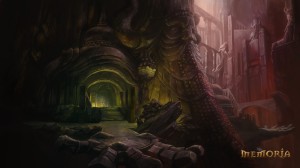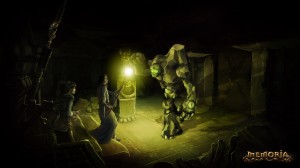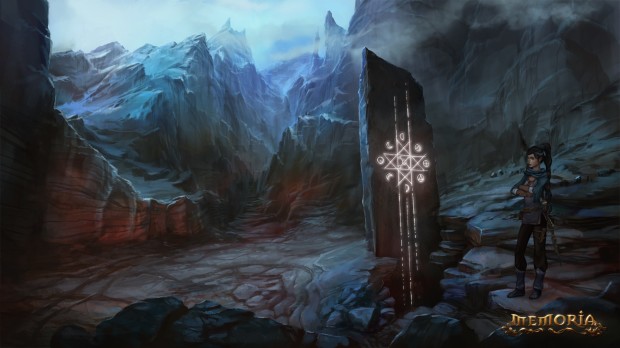A Review of Daedalic’s Memoria
This game was previewed on the PC.
Memoria is a continuation of The Dark Eye: Chains of Satinav, both point-and-click adventures created by Daedalic Entertainment. Set in the Kingdom of Andergast, a young bird catcher named Geron volunteers to help King Efferdan rid the land of the crow infestation that has been plaguing his land and haunting his citizens in their dreams. When Geron cannot remove the crows from the kingdom, he decides to seek out and capture a fairy that will be able to make a special concoction that will get rid of the crows. Instead of a cutesy, tiny little Tinkerbell, Geron catches a full-sized, human-like fairy named Nuri, with a mind of her own and a childish nature that gets her into all sorts of trouble. Unbeknownst to Geron, this adventure takes a magical, terrifying twist and he develops real feelings for Nuri, who by the end of Chains of Satinav is cursed into the form of a crow, creating a new motivation for Geron in Memoria.
The storyline in this sequel is like a delicately woven tapestry, with strands of information subtly making its way in and out of the scene, coaxing you further into its depths. Geron sets out to find a magical merchant named Fahi, who is rumoured to have what Geron needs to transform Nuri back to her natural form. But there’s a catch: Geron must listen to a tale of a lost princess named Sadja, who is said to have disappeared from history, and solve a riddle that was laid on the tomb where her journey truly began. In the game, you will switch between playing as Geron and Sadja as the storyline dictates, trying to solve the riddle that Fahi has laid before you. If you can figure out the answer to this riddle, he will grant you the ability to use a transformation spell that will let the wielder change any being’s form with ease.
When you play as Geron, you will have Nuri as a companion, who can perform various tasks to assist you, such as whispering to a crazy old man while behind a statue so he will let Geron pass through. Sadja, on the other hand, has a mystical talking staff that required a blood-and-smoke offering to be released, and can only speak directly to Sadja (in her mind) when they have physical contact. Each storyline uses unique magical abilities (like the ability to repair objects, or control stone Golems) and items found lying around to help you advance in the game and unravel more of the story.
 Memoria is not without its problems, however. While the story is engaging, the puzzles sometimes tend to really stretch logic, to the point where the characters sometimes even mislead the player. One such example is when Sadja is unable to pull a heavy chain out of a hole, telling you it’s too much work, but she has no problems doing it if you click on another hole in the wall. It’s like she suddenly finds the strength to lift the chain even though seconds before she wasn’t able to.
Memoria is not without its problems, however. While the story is engaging, the puzzles sometimes tend to really stretch logic, to the point where the characters sometimes even mislead the player. One such example is when Sadja is unable to pull a heavy chain out of a hole, telling you it’s too much work, but she has no problems doing it if you click on another hole in the wall. It’s like she suddenly finds the strength to lift the chain even though seconds before she wasn’t able to.
Adding to this misleading of players is the hints system. While the characters give you a basic understanding of the situation, and the hint menu tells you the basics behind what you need to do, it does so in a way that doesn’t give any substantial hints. It’s obvious Garen has to get back to the tent the merchant was in, and Nuri suggests whispering to the old man attempting to hear voices from the stone statues in the yard. Once there, you tell Nuri what to say about where the attackers came from, how many there were, etc., but there is no indication of what to look for in the combinations that will work and convince the old man to move along, and nothing to indicate you’ve done it incorrectly either. On top of this, since you have no clue what has happened, you have nothing lying around to indicate what the attacker (or attackers) were wearing, though that’s part of the puzzle. The lack of appropriate hints or direction, and the misleading phrases of the main characters can easily get players stuck and frustrated enough to put the game away for a few hours, or even forever.
Musically the game is pretty quiet, and rather than a soundtrack playing consistently, the game is filled with ambient noises, adding sound effects like droplets echoing through a cavern, creating hollowed out acoustic sounds, or fluttering and chirping birds hovering overhead in nearby trees. Between these moments of near-silence, the voice actors deliver their lines. There were a few characters (such as the mage during the tomb entrance scene) that embellished some of their syllables too often, creating an unrealistic and cheesy feel—but overall, the actors complemented each other and their characters nicely. Sadja and her companion are thankfully two of the more believable voices, with Sadja’s educated air in her tone, and the staff’s sarcastic and yet emotionally longing inserts. The main characters themselves do a wonderful job of delivering a mood that players will thoroughly enjoy.
Unlike other Daedalic Entertainment art, Memoria (and its predecessor, Chains of Satinav) has a more realistic character base. Instead of a little cartoony girl (or boy) and a strange talking rabbit, or a tall and goofy young lad, you have real heroic figures who exist in a fantasy world, but could easily be recognized cast as an actor in real life. There are some annoying graphical glitches, as the game seems to at times double up on images, creating a floating Sadja in the air in between scenes, or duplicating mouse pointers. That being said, the trademark Daedalic Entertainment style is still there in full form: beautiful hand-drawn backgrounds and animations, but the people and the settings are much more like something you would see in a fantasy novel, and much less like a Saturday morning cartoon. The lighting is also darker overall, with a few flecks of sunlight peeking through the scenes. If gorgeous artwork and seamless immersion is what you’re after, these games never seem to disappoint, and Memoria is no exception.
 If Daedalic Entertainment’s track record (with incredibly in-depth and plot-twisting storylines and gorgeous hand-painted visuals) is any indication, this game will be yet another winner in the point-and-click adventure genre, and if this is the kind of game that interests you, pick up The Dark Eye: Chains of Satinav to catch up on the storyline. Don’t worry, even if you only buy Memoria and play it as a standalone, you won’t have to worry about feeling like you’ve missed out, because the game is its own entity even as a continuation that you won’t feel lost. Memoria will be an adventure that will both intrigue and inspire gamers to click their way through the Kingdom of Andergast, searching to uncover the fate of both Geron and Sadja.
If Daedalic Entertainment’s track record (with incredibly in-depth and plot-twisting storylines and gorgeous hand-painted visuals) is any indication, this game will be yet another winner in the point-and-click adventure genre, and if this is the kind of game that interests you, pick up The Dark Eye: Chains of Satinav to catch up on the storyline. Don’t worry, even if you only buy Memoria and play it as a standalone, you won’t have to worry about feeling like you’ve missed out, because the game is its own entity even as a continuation that you won’t feel lost. Memoria will be an adventure that will both intrigue and inspire gamers to click their way through the Kingdom of Andergast, searching to uncover the fate of both Geron and Sadja.
About This Post
